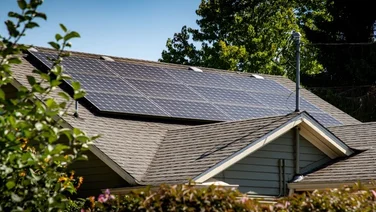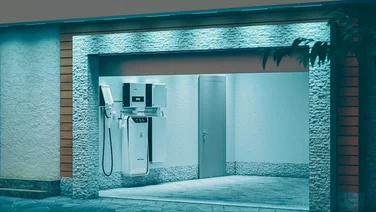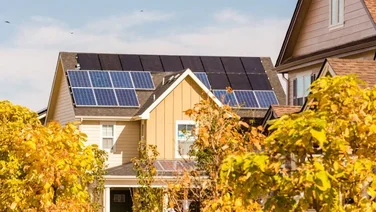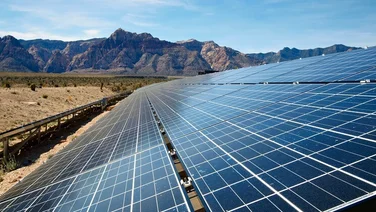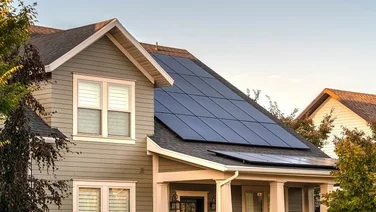- Do solar panels need direct sunlight in order to work?
- So can solar panels work in cloudy weather?
- What’s the best type of solar panel for cloudy weather?
- Do solar panels work in hail and snow?
- Do solar panels work in very hot weather?
- Are there any US states where solar panels aren’t suitable?
- Summary
✔ Solar panels still work under heavy cloud cover
✔ Panels don’t need direct sunlight to generate electricity
✔ The optimal temperature for solar panels is 77°F (25°C)
Solar panels are brilliant tools in helping homeowners generate clean electricity, without the need for carbon-heavy fossil fuels, all while saving them money on their energy bills.
That’s most likely why over three million homes in the US have installed solar panels, with solar power installations growing at a rate of 32% every year (National Renewable Energy Laboratory, 2022).
But do solar panels work on cloudy days? We’ve done the research and we’re here to tell you that they do — but different panels will work more effectively.
Read on to find out more.

Do solar panels need direct sunlight in order to work?
Solar panels don’t need direct sunlight to work — all they need is photons from the sun to hit them. And guess what: clouds don’t stop photons.
tThey do limit how many photons can make it from the sun to the solar panels, but they’ll still be piercing the cloud cover and helping you generate clean (and free) electricity.
So can solar panels work in cloudy weather?
Solar panels absolutely work in cloudy weather – just not quite as effectively as they would on a bright, sunny day.
In fact, panels are typically about 23.8% less effective under light cloud cover, meaning they’ll still generate more than enough electricity to power your home.
In heavy cloud cover, solar panel effectiveness drops to an average of 66.8%, which will still generate enough electricity to power basic appliances in your home, and keep essentials, such as your fridge, running.
Although 66.8% sounds like a large drop in output, think of it in terms of how much electricity you’ll be generating even under heavy clouds.
For context, a typical fridge will use about half a kilowatt hour (kWh) a day. If you have a typical 3.5 kW solar panel system, that’ll generate an average of 7.2 kWh of electricity a day. And under heavy clouds, the same system will generate 2.4 kWh of electricity per day — so you won’t need to worry about your fridge cutting out.
Which US states have the most cloudy days?
The US is a massive country, meaning the weather is wildly different from one state to the next. So the amount of electricity your solar panels can generate depends on which state you live in.
Want to know whether solar panels will be effective in your area? We’ve listed the US states with the most cloudy days below to give you an idea of the areas that might experience slightly lower solar output:
- Oregon: Oregon’s climate is influenced by the Pacific Ocean and the numerous mountain ridges — as ocean air drifts inland, the mountains force it higher to create clouds. That leads to some of the cloudiest weather in the US, meaning cities like Portland are lucky to see 50–75 sunny days a year.
- New York: The State of New York has several climate factors that make it a prime location for cloud cover. Storm tracks, cold air masses, and proximity to the Great Lakes all combine to shroud parts of the state under cloud cover for over 270 days a year.
- Alaska: Parts of Alaska actually get as much sun as the Great Plains, but it’s the shore along the Gulf of Alaska that brings the state into heavy cloud territory. The city of Juneau, for example, receives just 44 days of sunshine per year.
- Vermont: This perennially overcast state sees an average of just 58 days of full sunshine per year. Vermont’s cloudy weather is down to its position near the Lake Chaplain, the Atlantic Ocean, and the Green Mountains.
- Washington: The state of Washington takes the crown as the cloudiest place to live in the US. Cities like Olympia typically experience 313 cloudy days each year, because of the effects of the Pacific Ocean and weather generated by the Cascade mountains.
Just to be clear, your solar panels will still work to power your home with clean electricity, even in these cloudy states.

What’s the best type of solar panel for cloudy weather?
Monocrystalline solar panels are the best type of panel for cloudy weather, because they have the most efficient material for converting sunlight into electricity.
They’re up to 20% more effective at generating electricity from solar energy than standard polycrystalline panels, which is why they’re ideal for places with more cloud cover.
You’ll spend more per watt for monocrystalline solar panels, compared to polycrystalline — typically $1.5 versus $0.90 — but the extra efficiency makes them a better choice.
Do solar panels work in hail and snow?
Solar panels continue to work in hail and snow, just at a reduced efficiency rate. This is similar to how they operate under cloud cover, as the photons from the sun will still penetrate hail and snow to keep your panels generating electricity.
However, snow introduces its own potential problems — when it’s particularly heavy, you might find your panels getting buried under snow buildup.
Snow that’s allowed to settle on your solar panel system will block most if not all of the photons from the sun, meaning it won’t be able to generate electricity.
Do solar panels work in very hot weather?
Solar panels work in very hot weather, just not as effectively they do in cooler conditions. The optimal temperature for solar panels is 77°F (25°C).
As the temperature rises, the electrons generated by the solar panels start to bounce around faster. When this happens, the voltage gets reduced, and the amount of electricity the panels can make shrinks.
It seems odd that something designed to convert sunlight into electricity wouldn’t work as well when the sun’s at its strongest, but that’s physics.
The best type of solar panels for very hot weather are monocrystalline panels, because they have a higher tolerance for heat. That means they’re more effective in extreme temperature conditions, such as in deserts.
Are there any US states where solar panels aren’t suitable?
Even in the very northern US states, solar panels will work to power a property with clean energy. The panels might not work quite as well as solar systems further south, but you’ll still save money on your energy bills and reduce your reliance on the grid.
You should be aware that in particularly snowy states, solar panels won’t be as effective. If this is the case for your home, make sure to regularly clear snow buildup to keep your panels operating as best they can during the cold season.
Summary
Solar panels are key to helping homeowners shrink their energy bills, reduce emissions, and power their home using clean electricity.
For anyone concerned that clouds will stop solar panels from doing their job, don’t worry because as we’ve shown today, they’ll keep powering your home even on the most overcast days.
